Four-Seater Fury!
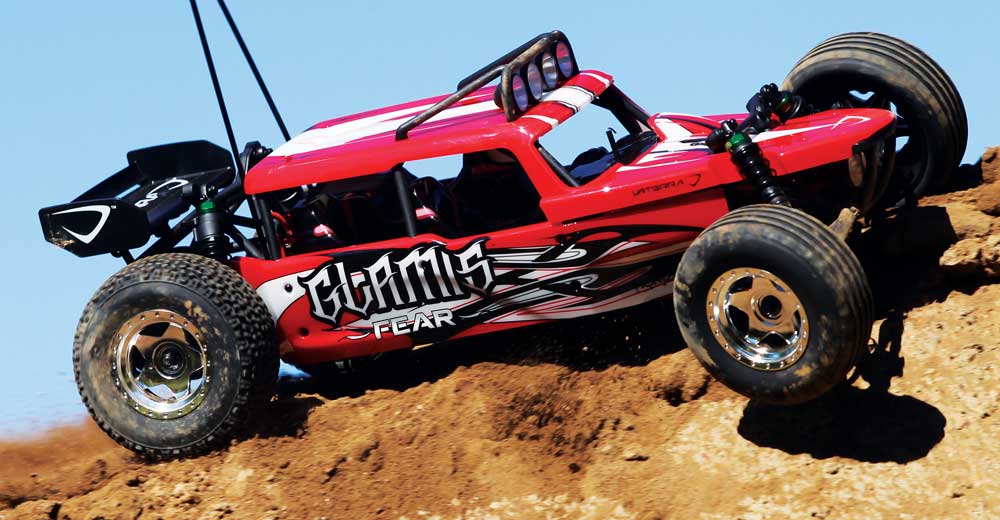
Words: Dean Berry
Photos: Walter Sidas
Face it, more people than not want just a few simple things when purchasing a radio controlled vehicle. Slick looks, crazy speed and durability are usually, if not always, the top three. Although the Vaterra brand is new, the people behind the scenes have been in the industry for what seems like an eternity and know how to deliver all this, and more, in a single release. Enter the new desert-conquering Glamis Fear. Based on the singleseater Glamis Uno that we reviewed in July of 2013, the Fear has taken this already well-loved platform and gives it a new look with a four-seater body and chassis design. The result, read on to find out…

AT A GLANCE
WHO MAKES IT: Vaterra
WHO IT’S FOR: Everyone
PART NUMBER: VTR4001
HOW MUCH: $419.99
BUILD TYPE: RTR
PROS
• It looks fantastic
• All you need is in one convenient box
• Dogbone/driveshaft boots are a standard item
• Powerful 4-pole 3300Kv brushless motor
• Waterproof electronics package
• Solid RTR radio system
• Low center of gravity
• Comes with a LiPo battery pack and charger
CONS
• The EC3 battery connectors are a little diffi cult to separate
• Shock bodies are threaded but it still uses pre-load clips
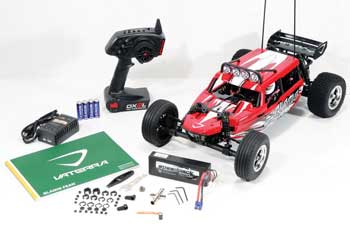
AUTHOR’S OPINION
I’m completely sold. It does not matter if you have been tinkering with RC cars for 20+ years or have been fiddling for the past 20 hours, everyone will love the Glamis Fear! It has the intangibles that words and statistics just fail to capture. It’s fast, looks absolutely fantastic, and despite my best efforts to break it, is nearly bulletproof in design. I can already see these flying off the shelves and being a top holiday gift for enthusiasts of all ages.
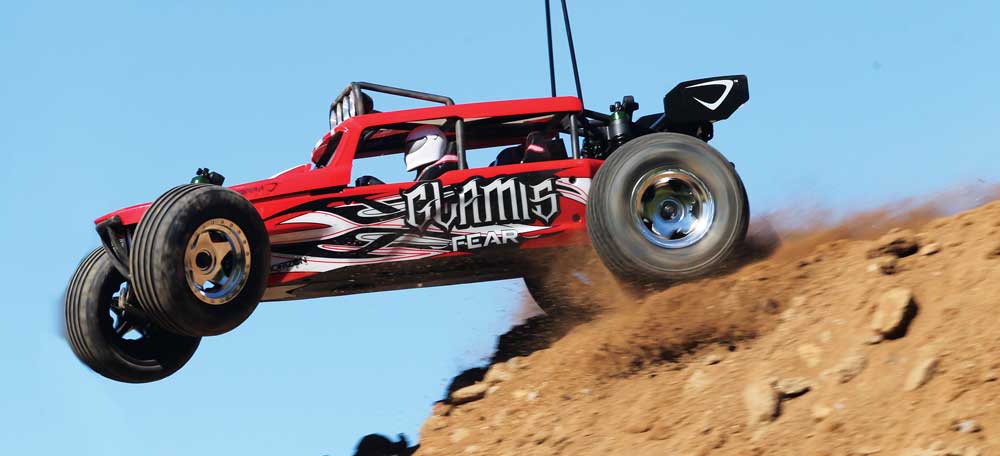
FEATURE BREAKDOWN
• Unlike the Glamis Uno that utilizes an aluminum channel-style chassis, the Fear uses a multi-piece chassis that features a composite main section. I really like this chassis because it wider than the original Uno chassis, making it ideal for the four-seater-style body that makes the Fear stand out from the crowd. The battery easily loads into the bottom of the chassis, helping keep the center of gravity very low and the battery box channel also adds a level of rigidity in the main chassis section. The front section of the chassis on the Fear features upper and lower aluminum plates. These are very tough and will absorb a great deal of abuse. The rear of the chassis also uses an aluminum chassis plate. I really like how the sections of this chassis are designed because just one section fail it is easy to replace as opposed to the entire backbone of the buggy.
• The Fear was designed to get air, BIG air. To help it do so with great success, Vaterra equipped it with bog bore shocks on all four corners. They feature threaded composite bodies for easy preload adjustment, although clips are used instead of threaded collars. They are very plush, and my favorite part features boots that protect the shock shafts and keep the oil fresh and clean for long periods of time. The shocks attach to tough, long, throw suspension arms that can smooth out the most aggressive terrain and feature multiple shock-mounting positions to fine tune the handling of the Fear. While the arms are beefy and sturdy they also have just enough flex to keep them durable.
• A standard-sized Spektrum S6170 digital steering servo attaches to a dual bellcrank-style steering rack and has decent torque and speed. This system works flawlessly and will continue to operate smoothly even after countless hours of use in dirt and sand. Adjustable turnbuckles attach to the center link of the dual bellcrank and allow for easy adjustment to toe. The turnbuckles also feature ball cups. While some people are not fans of ball cups and would rather capture style ends, I like them as they will pop off in a hard crash rather than break and possibly cause the metal turnbuckle to bend.
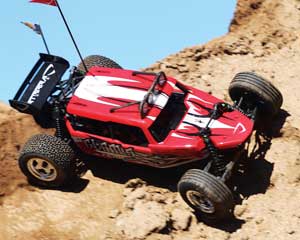
• The Fear utilizes 3-gear style transmission with all metal gears. While this is pretty much standard for 2WD off-road vehicles, the differential is what really stands out to me. Vaterra calls it a Viscous Torque Vectoring (VTV) differential. This sealed fluid filled-type differential has metal sun gears and four metal spider-type gears. This type of differential is ideal for limiting wheel spin when cornering or under hard acceleration and can be fine-tuned by changing the viscosity of the internal fluid. Additionally, the spur gear uses a dual friction-style slipper clutch that helps the driveline avoid premature wear. Power is transferred from the transmission to the wheels via dogbones. They are well-sealed with boots to keep sand out. Even so, they should be cleaned periodically because dirt can still sneak its way in and cause these parts to wear.
• The Fear comes delivered as a ready-to-run (RTR) and boasts a fantastic waterproof electronics package. First and foremost the radio box, located toward the front of the chassis, is completely sealed to protect the Spektrum receiver inside from the elements. The Dynamite Fuze 70A speed control is very versatile as it can handle the voltage from 2S and 3S LiPo battery packs. A sturdy cooling fan is mounted on top of the red anodized heatsink to keep it operating coolly and efficiently and is has EC3 battery connectors preinstalled. To get the wheels spinning, a 3300Kv Fuze brushless motor gets the nod from the people over at Vaterra. It has a 4-pole design for superior torque and blistering top speed.
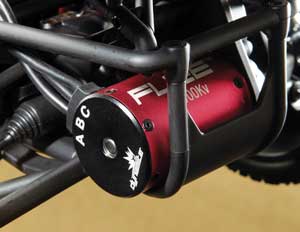
• It’s no fun hitting the dunes alone. Unlike the Uno, which is a single-seater, the Fear is a fourseater dune buggy with a unique body and roll cage with a killer red paint design and sick graphics. The body is secured on with two body clips and four screws. While it’s not hard to remove, it is not meant for quick access. For even more scale style there are six canister lights, two behind the front bumper and four on the roof. When the finishing touches are installed, twin flags are mounted toward the back of the Fear. They are secured to what seems to be spring steel rods and they act like a roll-over antenna that you might see on an older 1/12-scale pan car.
TOOLS & ACCESSORIES INCLUDED
• 4-way wrench
• 1.5mm, 2.0mm, 2.5mm L wrenches
• Slipper adjustment tool
• Shock tool
ITEMS NEEDED
• The Gamis Fear is completely ready-to-run
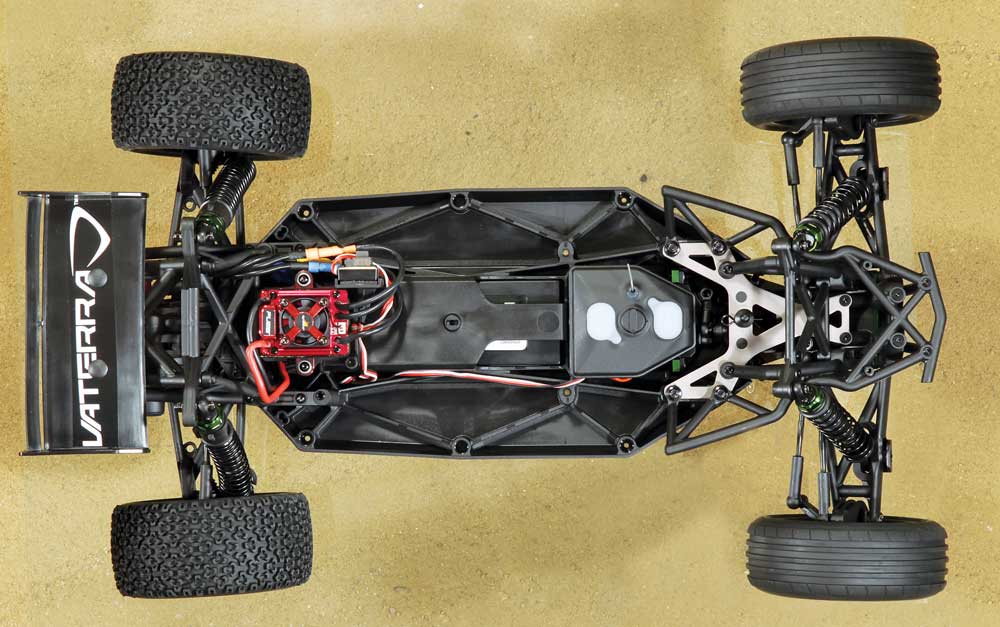
HOP-UPS WE RECOMMENED
• Dynamite Speedpak Platinum 11.1V 5200mAh 50C LiPo battery pack, DYNP4001EC, $119.99.
If you want to take the speed up a few notches, this 3S 11.1V LiPo battery pack from Dynamite is the ticket. It drops right on and no additional tools or items are needed to install it, you’ll just need an appropriate charger to power it up.
• Vaterra Rear Paddle Tires with Foam Inserts, VTR44004, $25.64.
Many people who are going to use the Fear will use it on sand. If this is you, these are ideal for you. They not only look great, but they will perform much better on sand than the stock tires.
• Swaybar Set, VTR344000, $13.99.
For those who want to thrash their Fear around and not worry about backing off the trigger to keep the handling tame, you might want to consider the rear swaybar set. This will settle the buggy down while ripping through corners.
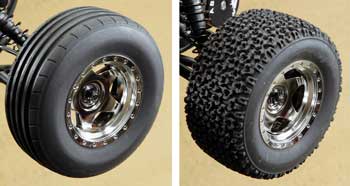
ON THE TRACK
STEERING: UNDERSTEER
I ran the Fear on dirt, asphalt and a stone-dust parking lot. The Spektrum steering servo is quick and has enough torque to snap the tires from side to side in a jiffy, even when the suspension compresses. Because of the ribbed front tires and chassis weight distribution, the front end feels well planted and really helps the Fear steer predictably. On dirt, there is a touch of understeer but this makes the Fear very easy to drive. This is especially helpful for entry lever drivers who might get frustrated with a vehicle that oversteers and might traction roll.
ACCELERATION: EXCELLENT
I knew the Fear was going to be quick since Vaterra equipped it with a 4-pole
3300Kv brushless motor and LiPo battery pack, but I had no idea how quick. When
I pulled the throttle back, the Fear lunged forward and took off, sending dirt, sand,
debris, and whatever else was under the Tetrapod tires flying. There was quite a
bit of wheel spin under hard acceleration, so I loosened the slipper clutch just a
touch and this really smoothed things out, especially on loose surfaces. The whole
package makes for smooth, liner power that makes the insane power of the Fear
very controllable.
BRAKING: VERY GOOD
The Dynamite Fuze speed control has a very strong brake. When applied hard, the rear wheels will lock up on command and can cause the Fear to slide and the front and rear end to change places. That said, if applied slowly or partially, braking is much smoother and more predictable.
SUSPENSION: EXCELLENT
The combination of the long throw shocks, suspension arms and over-sized tires really soaked up bumps, ruts and just about any surface imperfection that were in the Fear’s way. This enabled all four wheels to stay well-planted to the ground even at full speed and when cornering.
JUMPING: EXCELLENT
The Fear is a pure natural when it comes to taking flight. Jumps of all sizes and configurations posed little problem and the buggy sailed through the air, almost always with a level attitude, and landed squarely. This enabled me to get back on the throttle almost immediately. On the rare occasion the Fear was out of shape while in the air, a slight touch of throttle brought the nose up and a blip of brake easily brought it down.
DURABILITY: EXCELLENT
I jumped it far with several less-than-graceful landings, had a few cartwheel-style crashes and hit several pipes. Still, the Fear was unaffected and showed no signs of stopping or slowing, a testament to how well the people over at Vaterra designed the Glamis Fear.

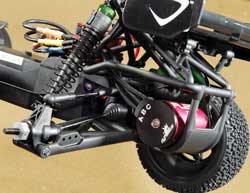
SPECS AND TUNING OPTIONS
DIMENSIONS
LENGTH: 18.7 in. (475mm)
WIDTH: 11.4 in. (290mm)
WHEELBASE: 13.66 in. (347mm)
WEIGHT: NA
BODY, WHEELS AND TIRES
BODY: Pre-painted polycarbonate
WHEELS: Plastic chrome
WHEEL ADAPTER TYPE: 12mm hex
TIRES: Vaterra S Compound ribbed front and off-road treaded rear
SUSPENSION
TYPE: 4-wheel independent
SHOCK POSITIONS: (F) 2-tower, 2-arm, (R) 2-tower, 3-arm
CAMBER: Adjustable turnbuckles
ROLL: NA
WHEELBASE: Fixed
RIDE HEIGHT: Preload clips
STEERING
TYPE: Dual bellcrank
TOE: Adjustable turnbuckles
CHASSIS
TYPE: Tub style with roll cage
MATERIAL: Composite plastic
THICKNESS: NA
DRIVETRAIN
TYPE: 2WD
TRANSMISSION: 3-gear rear-mounted
DIFFERENTIAL: Viscous torque vectoring gear differential
CLUTCH TYPE: Adjustable slipper
GEAR RATIO: Optional pinion gears
BEARINGS: Full set of shielded

WRAP UP
While there are no real, authentic sand dunes near my house, I may be looking for a new address much closer to some after driving the Glamis Fear from Vaterra. The Fear is everything it was designed to be and a whole lot more. Even though the Fear is not designed to be a race machine, racers will love it because of its performance and features while bashers will love the looks and durability. Since the introduction of the Uno, more and more desert-style vehicles have been released. Now, with the Fear, expect even more to flood the market as many manufacturers will no doubt be chasing Vaterra as they release four-seaters of their own.
LINKS
Dynamite dyamiterc.com, 800-338-4639
Spektrum spektrumrc.com, 800-338-4639
Vaterra vaterrarc.com, 800-338-4639
 RC Driver The Best In RC Car & Truck News, Reviews & Video
RC Driver The Best In RC Car & Truck News, Reviews & Video 







